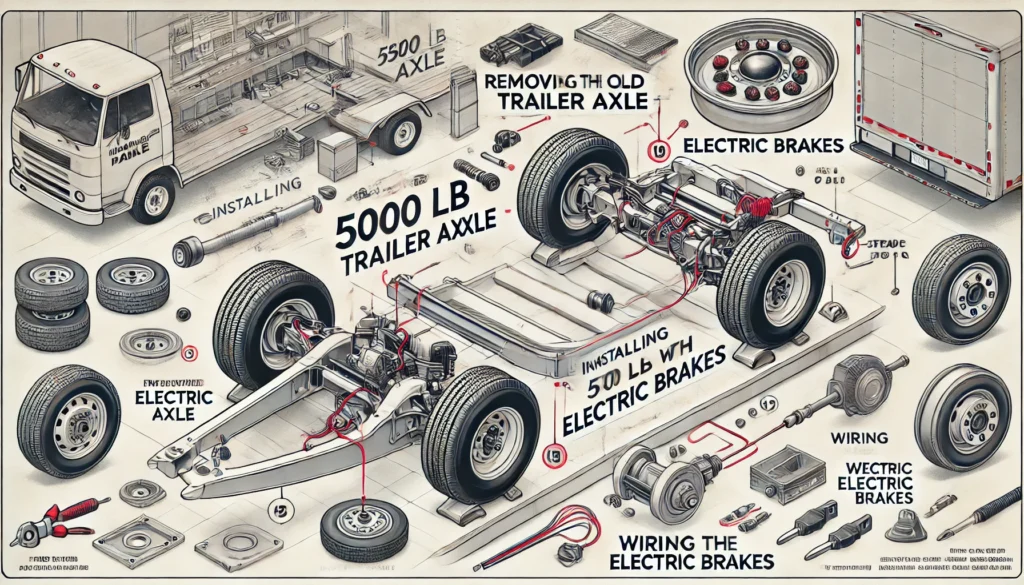When it comes to towing, having the right axle setup is crucial for safety and performance. A 5000 lb trailer axle with electric brakes is a popular choice for many trailer owners due to its durability and reliable braking power. In this guide, we’ll explore the benefits of this axle setup, how to choose the right one, and provide a step-by-step guide to installing it on your trailer.

Why Choose a 5000 lb Trailer Axle with Electric Brakes?
For those who tow heavier loads, the 5000 lb axle is ideal. This axle offers:
- Durability: Built to handle significant weight, it’s perfect for medium to heavy-duty trailers.
- Enhanced Braking Power: The inclusion of electric brakes ensures that your trailer stops safely, especially when towing heavy loads.
- Ease of Installation: These axles are designed for straightforward installation, making them a practical choice for both professionals and DIY enthusiasts.
Selecting the Right 5000 lb Trailer Axle with Electric Brakes
When choosing a trailer axle, consider the following:
- Axle Length: Measure your trailer to ensure the axle length matches your requirements. The correct length ensures proper alignment and load distribution.
- Brake Compatibility: Ensure the electric brakes are compatible with your towing vehicle’s brake controller.
- Suspension Type: Decide between leaf spring or torsion suspension based on your towing needs. Leaf springs are more common and easier to install, while torsion axles offer a smoother ride.
Step-by-Step Guide to Installing a 5000 lb Trailer Axle with Electric Brakes
Step 1: Gather Your Tools and Parts
Before beginning the installation, make sure you have the following:
- 5000 lb trailer axle with electric brakes
- Brake controller
- Wiring harness
- Jack and jack stands
- Lug wrench
- Screwdrivers and pliers
- Wire connectors and electrical tape
- Wrenches and socket set
Step 2: Prepare the Trailer
- Park the trailer on a flat, stable surface and secure it with wheel chocks.
- Use a jack to lift the trailer and place jack stands under the frame for safety.
- Remove the wheels to access the existing axle.
Step 3: Remove the Old Axle
- Loosen and remove the U-bolts or mounting hardware holding the old axle in place.
- Carefully slide the old axle out from under the trailer.
- If necessary, disconnect the brake wiring from the old axle.
Step 4: Install the New 5000 lb Axle
- Position the new axle under the trailer, aligning it with the leaf springs or torsion mounts.
- Secure the axle using U-bolts or the appropriate mounting hardware.
- Ensure that the axle is centered and aligned properly to prevent uneven tire wear.
Step 5: Connect the Electric Brakes
- Run the wiring from the brake controller in the towing vehicle to the trailer’s brake assemblies.
- Connect the brake wires to the wiring harness, ensuring secure and protected connections with electrical tape.
- Test the grounding of the brake assemblies to avoid electrical issues.
Step 6: Reattach the Wheels and Test the Setup
- Reinstall the wheels and lower the trailer from the jack stands.
- Perform a road test at low speed, applying the brakes gradually to ensure they engage smoothly.
- Adjust the brake controller settings as needed to achieve the desired braking force.
Maintenance Tips for Your 5000 lb Trailer Axle with Electric Brakes
- Regular Inspections: Check the brake pads, drums, and wiring for wear or damage.
- Lubrication: Apply grease to the bearings and moving parts to ensure smooth operation.
- Brake Controller Calibration: Periodically adjust the brake controller to maintain optimal performance.
Conclusion
A 5000 lb trailer axle with electric brakes is a robust and reliable choice for anyone needing to tow medium to heavy loads. By following this installation guide and maintaining your axle properly, you can ensure your trailer remains safe and road-ready for years to come.
